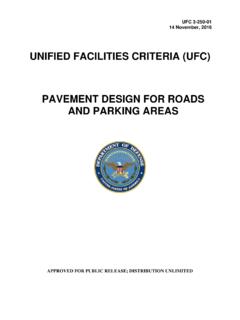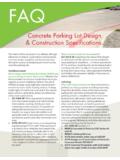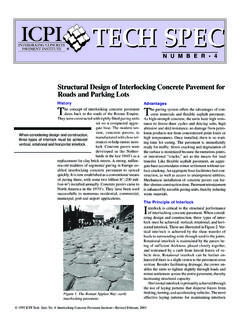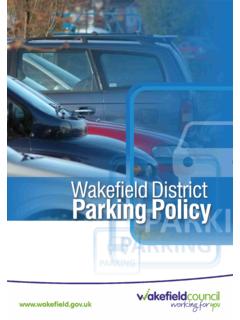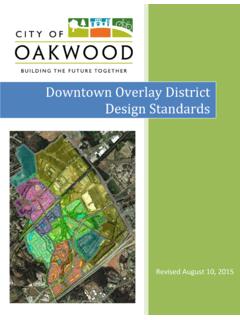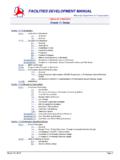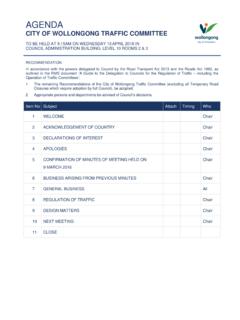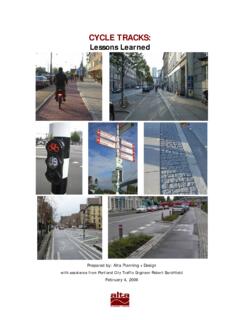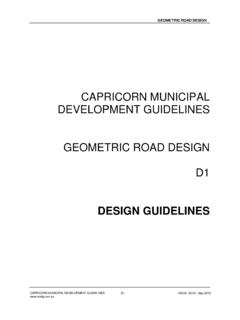Transcription of Residential Street Standards & Neighborhood Traffic Control
1 Residential Street Standards & Neighborhood Traffic Control : A Survey of Cities' Practices and Public Officials' Attitudes Eran Ben-Joseph Institute of Urban and Regional Planning University of California at Berkeley Abstract The failure of the local Street system to provide livability and safety in the Residential environment can be seen in the application of Neighborhood Traffic management programs by local authorities to mitigate Traffic problems. In order to further identify the extent of the conflict associated with "livability" and geometrical design of Residential Street , the following issues are examined: (1) Existing and proposed Residential streets Standards and regulations as practiced by various cities and their evaluation by public and city officials.
2 (2) Traffic problems associated with Residential streets and their mitigation through Traffic management and Control programs. Data are collected from Public Works and Traffic Engineering Departments of 56 Californian cities and 19 cities nation-wide. The findings show that most cities are still adhering to published Street Standards as recommended by different professional and federal organizations. Although some city officials see the need to amend certain aspects of their regulations and create a more flexible framework for Street design, most of them believe that the current practice is satisfactory.
3 Yet, the extant of residents' complaints about Traffic problems on their streets might indicate an inconsistency between professional practice, as manifested in Street design, and its actual performance as experienced by the residents. This can also be seen in the application of Traffic Control devices used by local authorities to mitigate these problems of which the most common are the installation of speed humps and 4-way stop signs. According to the cities' reports these techniques, as well as Traffic diverters have the most effective results. Acknowledgments This research has been supported in part by the Institute of Transportation Studies at the University of California at Berkeley, and the University of California Transportation Center.
4 I am also grateful for the guidance of Professor Michael Southworth at the department of City and Regional Planning and Landscape Architecture at the University of California at Berkeley. 1 INTRODUCTION The concept of the Street as a physical and social part of the living environment, as a place simultaneously used for vehicular movement, social contacts and civic activities, has long been argued by many authors such as Kevin Lynch, Jane Jacobs and Jackson. Local Residential streets in particular are central to the feeling of "community" and "belonging" within a Neighborhood .
5 Appleyard (1981) hypothesized that when Traffic volumes increase beyond what is considered normal by local residents, or vehicle speeds increase because of Street design, social Street activities are greatly reduced, and the feeling of well being in the affected Neighborhood is threatened. In order to protect livability as well as to provide for efficient movement of motor vehicles streets are given functional classifications. As such The Institute of Transportation Engineers report entitled, Recommended Guidelines for Subdivision Streets, establishes the following criteria in the design of local Street systems: Safety- for both vehicular and pedestrian Traffic .
6 Efficiency of Service- for all users. Livability or Amenities- especially as affected by Traffic elements in the circulation system. Economy- of land use, construction, and maintenance It further elaborates and provides the following principles: Adequate vehicular and pedestrian access should be provided to all parcels. Streets should be designed to minimize through Traffic . Elements in the local circulation system should not have to rely on extensive Traffic regulations in order to function efficiently and safely. Planning and construction of Residential streets should clearly indicate their local function.
7 The local Street should be designed for a relatively uniform low volume of Traffic . Local streets should be designed to discourage excessive speeds. Pedestrian-vehicular conflict points should be minimized. Minimum amount of space should be devoted to Street use. There should be a minimum number of intersections. (ITE, 1984) Although, ITE recommended criteria refer to issues of livability and safety on Residential streets, many cities are finding themselves under pressure to further address these issues through the reduction of speed and volume of Traffic on Residential streets.
8 While Traffic volume is often the 2 result of a poorly planned Street system, safety and excessive speed are related to the Street 's geometrical design. The practice of constructing relatively wide cross sections in Residential streets where there is little Traffic (less than 1000 trips per day), permits and encourages high vehicle speeds. High speeds are also encouraged by pavement width, smoothness, flat curves and good sight distance called for in Street standards1 This relationship between design speed and sight distance, curve radius, and width have been established to provide motorized efficiency which is often incompatible with the essence of Residential livability.
9 Published geometrical Street Standards do not always adhere to the stated principles for Residential Street systems. The failure of existing local Street systems, and the Street 's physical design, to provide livability and safety associated with the Residential environment, can be seen in the application of Traffic management strategies and Control devices used by local authorities to mitigate these problems. These management programs are generally assigned to the following sequential categories: 1. Establishing, revising, and enforcing laws and ordinances pertaining to Traffic regulations such as: speed limits, intersection Control and parking regulations.
10 2. Installing Traffic Control devices that comply with the Manual on Uniform Traffic Control Devices such as: regulatory and warning signs, markings, Traffic signals and Traffic islands. 3. Installing physical design features that manage the movement and reduce the speed of vehicles: speed humps, pavement narrowing, shift in pavement, Traffic circles and Traffic diverters. Study Objectives Against this background of issues, a detailed study of existing and proposed regulations, showing their use and results as found in many cities, would be of particular value to those enacting legislation and procedures.










